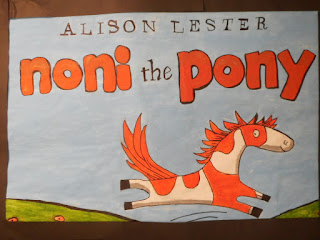I thought I might use this post to reflect on our :
2015 Book Week celebrations
Our week began last Friday with the announcement of the CBCA winners for this year and YES there were some huge surprises (or even shocks). As one young reader commented - who are these judges?
Some of our favourites received prizes and others did not. Happily some of my predictions came true.
Picture Book of the Year
We read The Stone Lion to nearly every Primary class and the response was wonderful. Margaret Wild is a national treasure. Her books always resonate with truth and magic. Sadly in this same category, The Duck and the Darklings, which I adored did not receive any awards this time. Our senior classes had read and discussed the winner My Two blankets several weeks ago - it was one of the very best discussions I have had with any class this year. I know this book will feature on in my program in the future especially when my senior students are examining our Multicultural nation as part of their HSIE class work.
Early Childhood Picture Book
Nearly every child in my school expected Pig the Pug to win. Even before reading this book it was the popular choice. This book did not receive any awards but I did read it to every class this week and much laughter was heard. The winner and honour books in this category are for very young children but my Kindergarten and Grade One children did enjoy the familiar scenes in Go to Sleep Jessie and the rhymes and illustrations in Scary Night and Noni the pony goes to the Beach. Below you can see the cover painted by one of our classes many years ago of the first Noni title. We have a spledid set of over 50 of these enormous posters in our library.
Younger Readers
I will begin by saying I think this section needs a new name and perhaps new criteria. It seems odd to judge a splendid book like Withering by Sea against the eventual winner The Cleo Stories. It was this section that elicited the comment above. Sadly Figgy in the World did not feature among the winners either. You can read about the other Honour book Two Wolves here.
Our School celebrations
Unlike many Australian schools - we do not hold book character parades in my school. I feel they have little or no connection to reading and often become a competition between parents. In other families the need to find or make costumes is, I feel, an unnecessary stress. Instead we have activities for every single day of book week. Our library hosts special lunch events including craft sessions with our youngest students (you might like to read about MakerSpaces). For our older students every day we announce a thinking challenge. These are completed during the school day and we present prize bags and merit awards for the best work. You can see some examples above and below this post. This year our challenges were
- Puzzle me a puzzle - make a game or puzzle using the Book Week Slogan Books light up our world
- Recycle recycle - three uses for a used light globe. Go one step further and make a colourful poster to present your ideas in a hardware store
- Light me a light - design a new light for our library foyer. Go one step further and include instructions explaining how this light works
- Making it personal - write a tweet (140 characters) to explain how one book lit up your world. Go one step further and present this as a book mark.
We received hundreds of entries for each challenge. I almost ran out of prizes!












